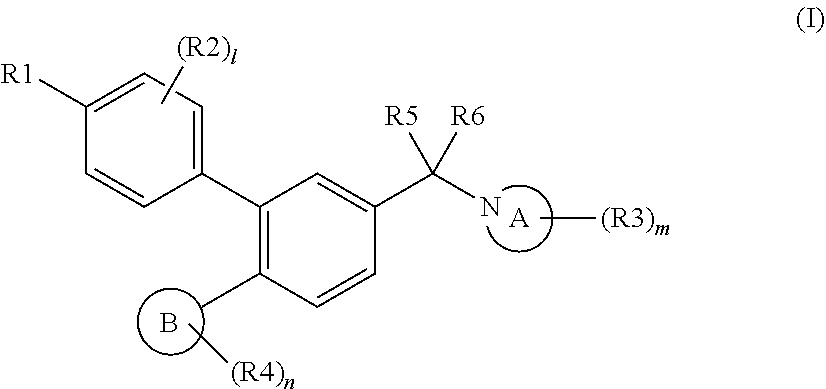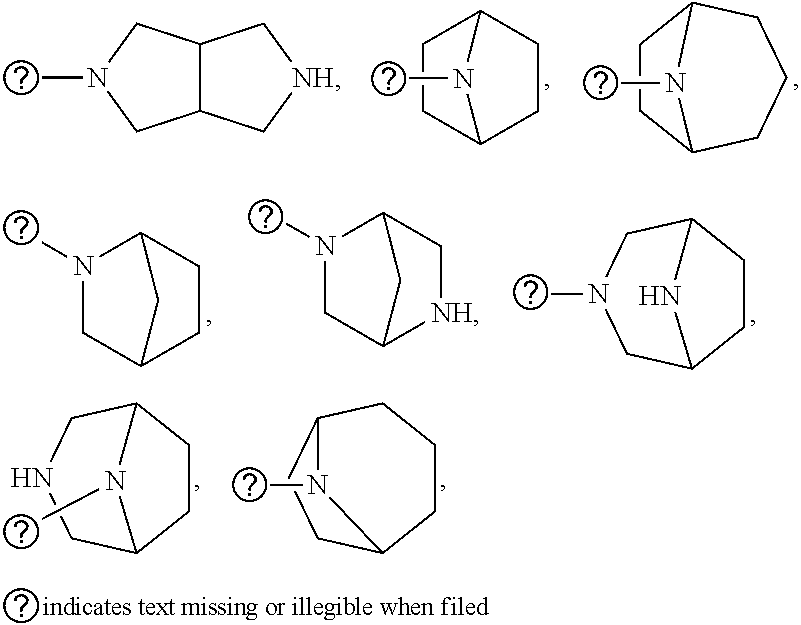Novel biphenyl compound or salt thereof
a biphenyl compound and compound technology, applied in the field of new biphenyl compounds, can solve the problems of cell cancerization, cell cancerization, extremely short life, etc., and achieve the effects of preventing and/or treating cancer, excellent lsd1 inhibitory activity and a cancer cell growth inhibitory
- Summary
- Abstract
- Description
- Claims
- Application Information
AI Technical Summary
Benefits of technology
Problems solved by technology
Method used
Image
Examples
example 1
of 4-[5-[(3S)-3-aminopyrrolidine-1-carbonyl]-2-(p-tolyl)phenyl]benzonitrile
Step 1
[0235]3-Bromo-4-chloro-benzoic acid (19 g) was dissolved in DMF (160 mL). At 25° C., DMAP (20 g) and WSC HCl (31 g) were added thereto, followed by the addition of t-BuOH (38 mL). The resulting mixture was stirred at room temperature overnight. Ethyl acetate was added thereto, and the resulting mixture was washed sequentially with water and saturated brine. After the organic layer was dried over anhydrous sodium sulfate, the solvent was distilled off. The residue was purified by silica gel column chromatography (mobile phase: hexane / ethyl acetate) to give tert-butyl 3-bromo-4-chloro-benzoate.
Step 2
[0236]The tert-butyl 3-bromo-4-chloro-benzoate (1.3 g) obtained in step 1 above was dissolved in 1,4-dioxane (8.7 mL). At room temperature, (4-cyanophenyl)boronic acid (768 mg), Pd(PPh3)4 (151 mg), and a 2 M sodium carbonate aqueous solution (5.4 mL) were added thereto, and the reaction mixture was stirred in ...
example 2
of 4-[5-[(3S)-3-aminopyrrolidine-1-carbothioyl]-2-(p-tolyl)phenyl]benzonitrile
[0240]The 4-[5-[(3S)-3-aminopyrrolidine-1-carbonyl]-2-(p-tolyl)phenyl]benzonitrile (6 mg) obtained in step 5 of Example 1 was dissolved in THF (0.8 mL). At room temperature, Lawesson's reagent (3.8 mg) was added thereto, followed by stirring at room temperature for 30 minutes. Chloroform was added thereto, and the mixture was partitioned with sodium bicarbonate water. After the organic layer was dried over anhydrous sodium sulfate, the solvent was distilled off. The residue was purified by reversed-phase HPLC (mobile phase: water / acetonitrile) to give the title compound.
example 3
of 4-[5-(4-aminopiperidine-1-carbonyl)-2-(p-tolyl)phenyl]benzonitrile
Step 1
[0241]The 3-(4-cyanophenyl)-4-(p-tolyl)benzoic acid (20 mg) obtained in step 3 of Example 1 was dissolved in THF (1 mL). At room temperature, tert-butyl N-(4-piperidyl)carbamate (13 mg), HATU (49 mg), and TEA (0.027 mL) were added thereto, followed by stirring at 50° C. overnight. The reaction mixture was vacuum-concentrated, and the solvent was distilled off. The residue was purified by silica gel column chromatography (mobile phase: hexane / ethyl acetate) to give tert-butyl N-[1-[3-(4-cyanophenyl)-4-(p-tolyl)benzoyl]-4-piperidyl]carbamate.
Step 2
[0242]The tert-butyl N-[1-[3-(4-cyanophenyl)-4-(p-tolyl)benzoyl]-4-piperidyl]carbamate (30 mg) obtained in step 1 above was dissolved in TFA (0.3 mL), and the progress of the reaction was confirmed by LCMS, followed by vacuum concentration. The residue was purified by reversed-phase HPLC (mobile phase: water / acetonitrile) to give the title compound.
PUM
| Property | Measurement | Unit |
|---|---|---|
| temperature | aaaaa | aaaaa |
| temperature | aaaaa | aaaaa |
| reaction temperature | aaaaa | aaaaa |
Abstract
Description
Claims
Application Information
 Login to View More
Login to View More - R&D
- Intellectual Property
- Life Sciences
- Materials
- Tech Scout
- Unparalleled Data Quality
- Higher Quality Content
- 60% Fewer Hallucinations
Browse by: Latest US Patents, China's latest patents, Technical Efficacy Thesaurus, Application Domain, Technology Topic, Popular Technical Reports.
© 2025 PatSnap. All rights reserved.Legal|Privacy policy|Modern Slavery Act Transparency Statement|Sitemap|About US| Contact US: help@patsnap.com



